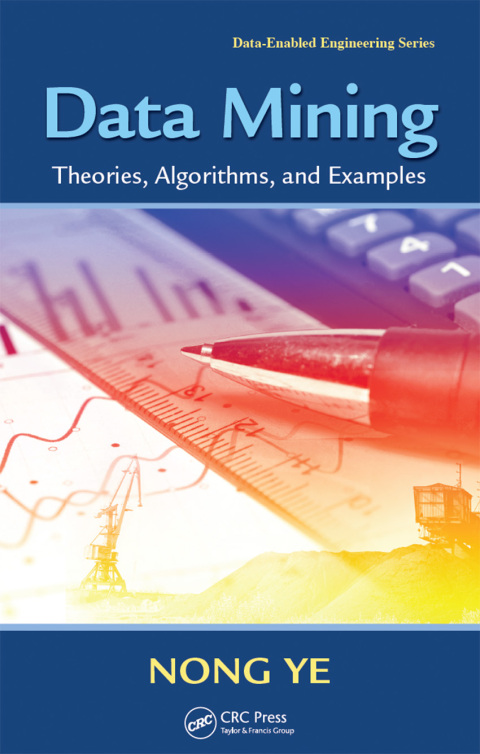Description
Efnisyfirlit
- Cover
- Half Title
- Title Page
- Copyright Page
- Table of Contents
- Preface
- Acknowledgments
- Author
- Part I An Overview of Data Mining
- 1. Introduction to Data, Data Patterns, and Data Mining
- 1.1 Examples of Small Data Sets
- 1.2 Types of Data Variables
- 1.2.1 Attribute Variable versus Target Variable
- 1.2.2 Categorical Variable versus Numeric Variable
- 1.3 Data Patterns Learned through Data Mining
- 1.3.1 Classification and Prediction Patterns
- 1.3.2 Cluster and Association Patterns
- 1.3.3 Data Reduction Patterns
- 1.3.4 Outlier and Anomaly Patterns
- 1.3.5 Sequential and Temporal Patterns
- 1.4 Training Data and Test Data
- Exercises
- Part II Algorithms for Mining Classification and Prediction Patterns
- 2. Linear and Nonlinear Regression Models
- 2.1 Linear Regression Models
- 2.2 Least-Squares Method and Maximum Likelihood Method of Parameter Estimation
- 2.3 Nonlinear Regression Models and Parameter Estimation
- 2.4 Software and Applications
- Exercises
- 3. Naïve Bayes Classifier
- 3.1 Bayes Theorem
- 3.2 Classification Based on the Bayes Theorem and Naïve Bayes Classifier
- 3.3 Software and Applications
- Exercises
- 4. Decision and Regression Trees
- 4.1 Learning a Binary Decision Tree and Classifying Data Using a Decision Tree
- 4.1.1 Elements of a Decision Tree
- 4.1.2 Decision Tree with the Minimum Description Length
- 4.1.3 Split Selection Methods
- 4.1.4 Algorithm for the Top-Down Construction of a Decision Tree
- 4.1.5 Classifying Data Using a Decision Tree
- 4.2 Learning a Nonbinary Decision Tree
- 4.3 Handling Numeric and Missing Values of Attribute Variables
- 4.4 Handling a Numeric Target Variable and Constructing a Regression Tree
- 4.5 Advantages and Shortcomings of the Decision Tree Algorithm
- 4.6 Software and Applications
- Exercises
- 5. Artificial Neural Networks for Classification and Prediction
- 5.1 Processing Units of ANNs
- 5.2 Architectures of ANNs
- 5.3 Methods of Determining Connection Weights for a Perceptron
- 5.3.1 Perceptron
- 5.3.2 Properties of a Processing Unit
- 5.3.3 Graphical Method of Determining Connection Weights and Biases
- 5.3.4 Learning Method of Determining Connection Weights and Biases
- 5.3.5 Limitation of a Perceptron
- 5.4 Back-Propagation Learning Method for a Multilayer Feedforward ANN
- 5.5 Empirical Selection of an ANN Architecture for a Good Fit to Data
- 5.6 Software and Applications
- Exercises
- 6. Support Vector Machines
- 6.1 Theoretical Foundation for Formulating and Solving an Optimization Problem to Learn a Classification Function
- 6.2 SVM Formulation for a Linear Classifier and a Linearly Separable Problem
- 6.3 Geometric Interpretation of the SVM Formulation for the Linear Classifier
- 6.4 Solution of the Quadratic Programming Problem for a Linear Classifier
- 6.5 SVM Formulation for a Linear Classifier and a Nonlinearly Separable Problem
- 6.6 SVM Formulation for a Nonlinear Classifier and a Nonlinearly Separable Problem
- 6.7 Methods of Using SVM for Multi-Class Classification Problems
- 6.8 Comparison of ANN and SVM
- 6.9 Software and Applications
- Exercises
- 7. k-Nearest Neighbor Classifier and Supervised Clustering
- 7.1 k-Nearest Neighbor Classifier
- 7.2 Supervised Clustering
- 7.3 Software and Applications
- Exercises
- Part III Algorithms for Mining Cluster and Association Patterns
- 8. Hierarchical Clustering
- 8.1 Procedure of Agglomerative Hierarchical Clustering
- 8.2 Methods of Determining the Distance between Two Clusters
- 8.3 Illustration of the Hierarchical Clustering Procedure
- 8.4 Nonmonotonic Tree of Hierarchical Clustering
- 8.5 Software and Applications
- Exercises
- 9. K-Means Clustering and Density-Based Clustering
- 9.1 K-Means Clustering
- 9.2 Density-Based Clustering
- 9.3 Software and Applications
- Exercises
- 10. Self-Organizing Map
- 10.1 Algorithm of Self-Organizing Map
- 10.2 Software and Applications
- Exercises
- 11. Probability Distributions of Univariate Data
- 11.1 Probability Distribution of Univariate Data and Probability Distribution Characteristics of Various Data Patterns
- 11.2 Method of Distinguishing Four Probability Distributions
- 11.3 Software and Applications
- Exercises
- 12. Association Rules
- 12.1 Definition of Association Rules and Measures of Association
- 12.2 Association Rule Discovery
- 12.3 Software and Applications
- Exercises
- 13. Bayesian Network
- 13.1 Structure of a Bayesian Network and Probability Distributions of Variables
- 13.2 Probabilistic Inference
- 13.3 Learning of a Bayesian Network
- 13.4 Software and Applications
- Exercises
- Part IV Algorithms for Mining Data Reduction Patterns
- 14. Principal Component Analysis
- 14.1 Review of Multivariate Statistics
- 14.2 Review of Matrix Algebra
- 14.3 Principal Component Analysis
- 14.4 Software and Applications
- Exercises
- 15. Multidimensional Scaling
- 15.1 Algorithm of MDS
- 15.2 Number of Dimensions
- 15.3 INDSCALE for Weighted MDS
- 15.4 Software and Applications
- Exercises
- Part V Algorithms for Mining Outlier and Anomaly Patterns
- 16. Univariate Control Charts
- 16.1 Shewhart Control Charts
- 16.2 CUSUM Control Charts
- 16.3 EWMA Control Charts
- 16.4 Cuscore Control Charts
- 16.5 Receiver Operating Curve (ROC) for Evaluation and Comparison of Control Charts
- 16.6 Software and Applications
- Exercises
- 17. Multivariate Control Charts
- 17.1 Hotelling’s T2 Control Charts
- 17.2 Multivariate EWMA Control Charts
- 17.3 Chi-Square Control Charts
- 17.4 Applications
- Exercises
- Part VI Algorithms for Mining Sequential and Temporal Patterns
- 18. Autocorrelation and Time Series Analysis
- 18.1 Autocorrelation
- 18.2 Stationarity and Nonstationarity
- 18.3 ARMA Models of Stationary Series Data
- 18.4 ACF and PACF Characteristics of ARMA Models
- 18.5 Transformations of Nonstationary Series Data and ARIMA Models
- 18.6 Software and Applications
- Exercises
- 19. Markov Chain Models and Hidden Markov Models
- 19.1 Markov Chain Models
- 19.2 Hidden Markov Models
- 19.3 Learning Hidden Markov Models
- 19.4 Software and Applications
- Exercises
- 20. Wavelet Analysis
- 20.1 Definition of Wavelet
- 20.2 Wavelet Transform of Time Series Data
- 20.3 Reconstruction of Time Series Data from Wavelet Coefficients
- 20.4 Software and Applications
- Exercises
- References
- Index






Reviews
There are no reviews yet.